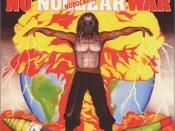The Tale of Happiton is a great story that demonstrates many qualities about individuals. Hofstadter created a situation where the townspeople of Happiton were faced with a very difficult situation brought on by a demon, and would have to write plenty of postcards in order to help slow down the bell that would possibly ring their doom. Even though, the chances were very low on a day-to-day basis that all five dice would land on 7, the probabilities would grow higher and higher as months, and years went by. In this tale, Hofstadter depicts humans to be very concerned, creative, hopeful individuals who later become lazy, careless, and free of responsibilities.
In the beginning of the tale, when the news of the possible retchgoo to be spread came about, most of the townspeople were concerned. Many ideas were contemplated for the massive production of postcards; even 1205 people to write postcards as their full-time jobs.
For instance, 11-year-old Wally Thurston went out and bought $14.22 worth of 88-cent postcards. A sophomore, Andre McKenzie, had nightmares about the retchgoo. There were also some people who had different views, which is expected in an instance where 20,000 people may have different views on a matter. Hank Hoople, a janitor at Happiton High, seemed rather glum about the situation, stating that it is all fate that has brought this upon the townspeople. Also, 77-year-old Lulu Smith said she thought it was all a ruckus in a teapot, and will carry on selling thread 'n needles.
Whether or not most of the townspeople expressed concern and thought of plenty solutions to help produce several postcards, towards the end of the tale, people lost hope. The only person in the tale that even cared at all about the devastating situation was Andre McKenzie, the high...


